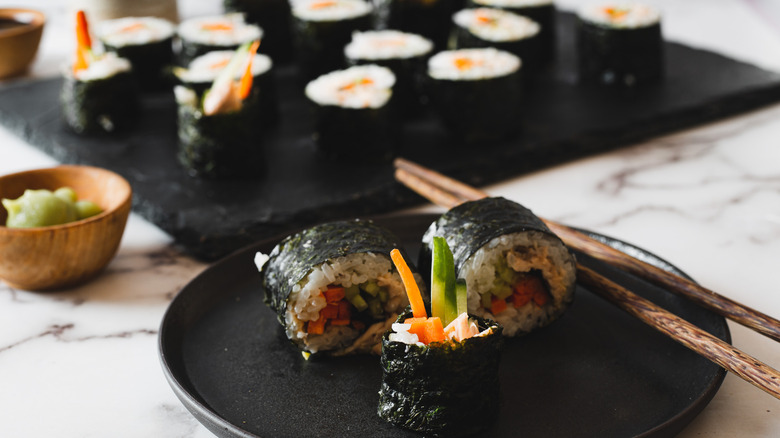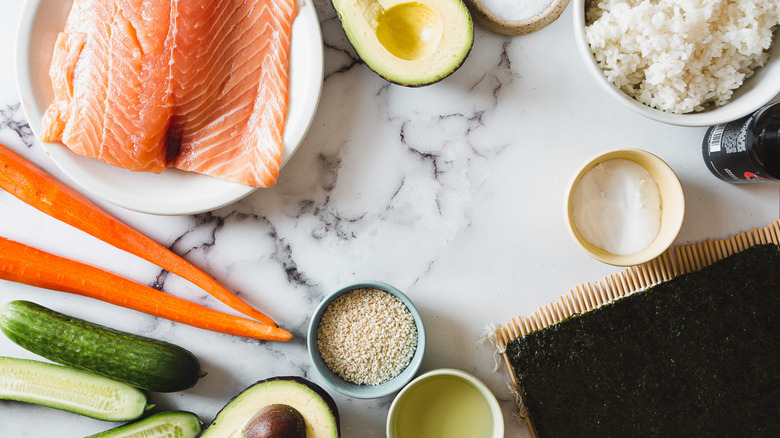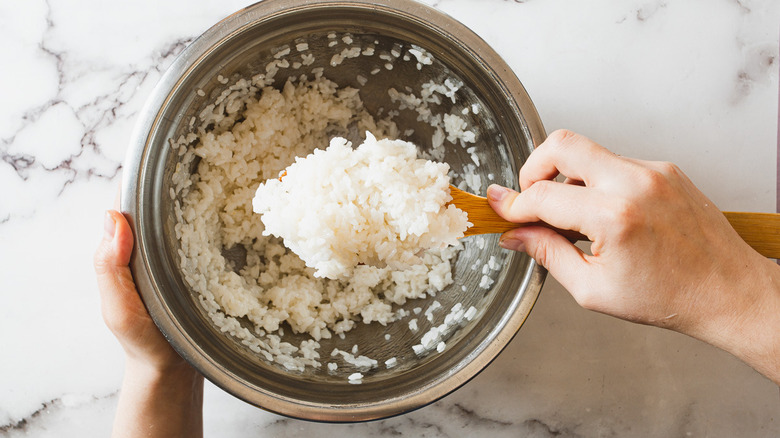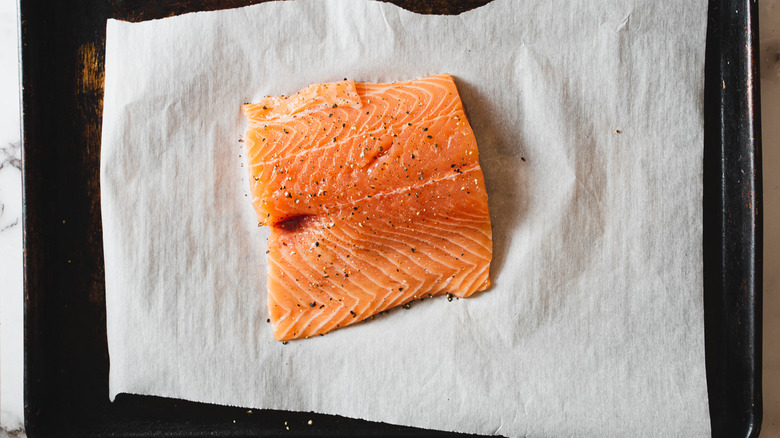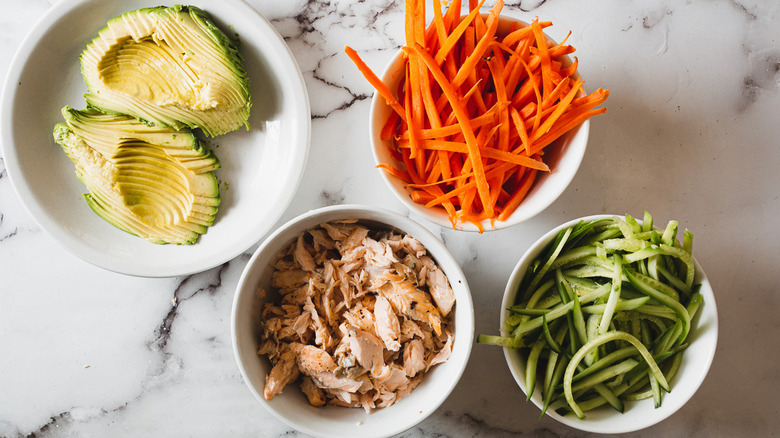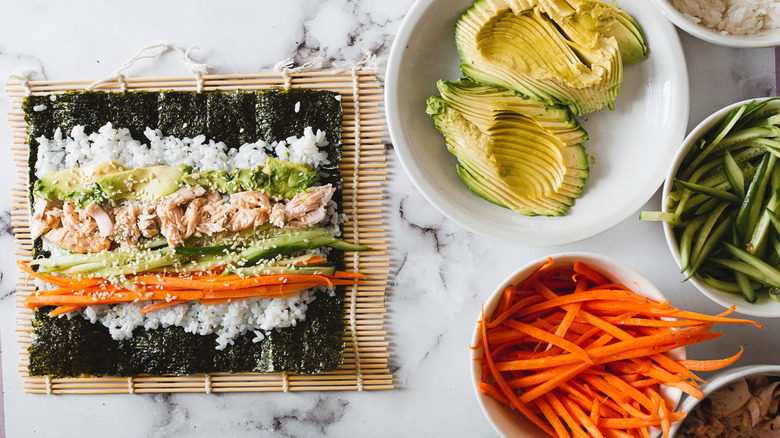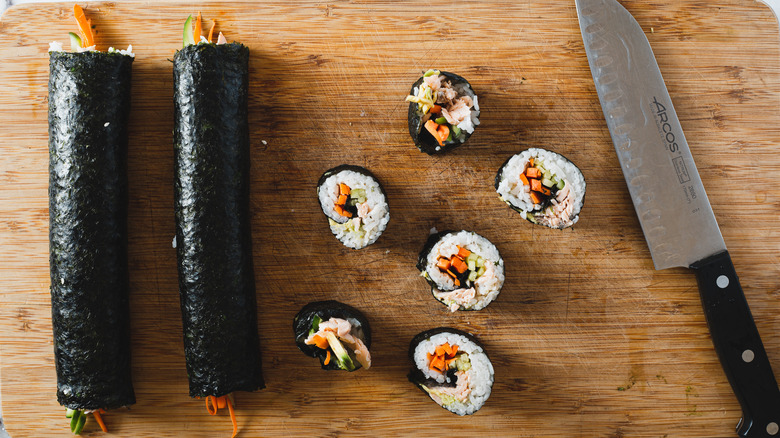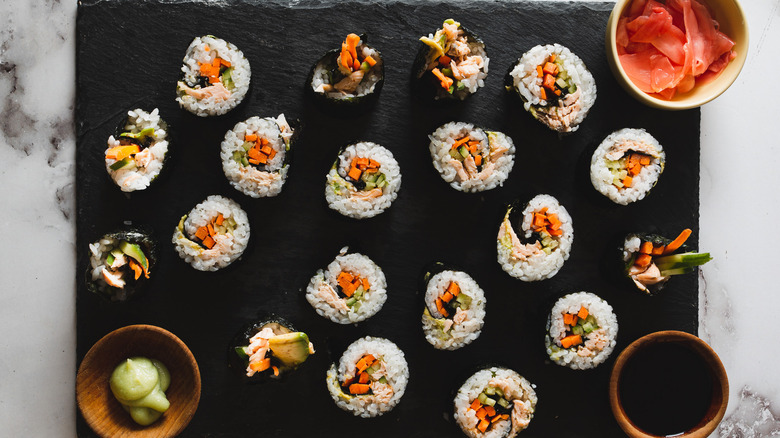Baked Salmon Sushi Recipe
Baked salmon sushi is the gateway drug to making sushi at home — made of entirely cooked, easy-to-find ingredients, these delicious sushi rolls truly showcase the variety of freshly made sushi.
Cooked sushi often gets a bad rep in the sushi world, food blogger and photographer Ksenia Prints of At the Immigrant's Table tells us. While everyone knows raw tuna and salmon make for great sushi rolls, few people dare mess with those ingredients at home. Yet no one thinks that cooked sushi can taste just as good as raw.
Enter baked salmon sushi to change people's minds. A mix of simple baked salmon, fork-flaked to perfection, sweet julienned carrots, refreshing cucumber, and creamy avocado, these rolls are fresh, healthy, and perfectly satisfying. Topped with a dollop of spicy mayonnaise or wasabi-tinged soy sauce, they make for a very worthy sushi feast at home.
Once you taste our baked salmon sushi rolls, you'll forget you ever used to look down on sushi made with cooked fish.
Gather the ingredients
Our baked salmon sushi rolls are fresh, healthy and wholesome, and the ingredient list perfectly showcases this. As the basis for sushi, you will need to grab nori sheets and short-grain white rice. This rice is the rice of choice for sushi making, thanks to its high starch quotient, which makes it extra sticky. You can find both ingredients in the Asian food aisle, or in specialty Asian markets. Short-grain arborio rice also works as a substitute for sushi rice.
To flavor the rice, you will need some rice vinegar, sugar, and salt.
As the filling for our baked salmon sushi rolls, you will need a 6-ounce piece of fresh salmon, a carrot, 2 Lebanese cucumbers or 1 English cucumber, an avocado, and some sesame seeds. All the veggies will need to be julienned for the sushi, and the avocado cut into thin slices.
To go alongside our sushi roll, we recommend you grab your favorite sushi accompaniments: soy sauce, pickled ginger, and wasabi are the most common choices.
Prepare the sushi rice
First, let us start by flavoring the rice for our sushi rolls. Aim to make your rice a few hours before assembling the sushi, as it needs ample time to cool to room temperature (you can also help cool it down with a hair dryer set to cold air or a fan, as they do in the best sushi places).
Cook the rice according to package instructions. This usually entails combining rice and water in a large pot in a 2:1 ratio, bringing it to a boil and then cooking the rice on the lowest heat for 12 minutes.
Season the cooked sushi rice with 3 tablespoons rice vinegar, 1 1/2 tablespoons of sugar, and 1/2 teaspoon of salt, and stir to combine. Allow the rice to cool completely before proceeding.
Bake the salmon
Preheat the oven to 400 degrees Fahrenheit. Line a baking sheet with parchment paper or aluminum foil. This will prevent the salmon from sticking and make clean-up considerably easier.
If your salmon is not completely skinless, remove the skin from the bottom of the fish using a sharp knife. Season the salmon with 1/2 teaspoon of salt and 1/4 teaspoon of pepper on both sides. Transfer the fish to the baking sheet and roast until just cooked through, 8 to 10 minutes. Cool, and then flake with a fork into large bite-sized pieces.
Prepare remaining vegetables for sushi rolls
Arrange julienned carrots, cucumbers, and avocado slices in separate bowls. Transfer the flaked baked salmon to its own bowl as well.
If you are unsure what it means to julienne a carrot and a cucumber, it means to slice them into thin, matchstick-like shapes. These are easy to chew through and process even when raw, and they do not interfere with the texture of sushi. In fact, fresh vegetables often help add an element of crunch and a burst of fresh flavor to sushi.
In our baked salmon sushi, avocado provides a creamy texture, while carrots and cucumbers will provide bursts of fresh sweetness alongside the flaky salmon.
Assemble and roll the baked salmon sushi
On a cutting board or flat surface, lay a bamboo sushi rolling mat. Place a piece of nori on the mat, shiny side down. Set a small bowl of warm water beside your sushi mat. Wet your hands, and spread approximately 3/4 cup of rice across 2/3 of the nori sheet, leaving about 1/3 of the nori sheet empty on the top.
Starting about 1 inch from the bottom of the rice, arrange a layer of carrots, followed by a layer of cucumbers, then a spoonful of salmon, and a few slices of avocado. Sprinkle with sesame seeds.
Grab the mat and lightly hold the nori from the bottom. Begin to roll the mat upwards, firmly applying pressure down to keep the roll tight, using your fingers to tuck any errant tuna filling in. Continue rolling tightly until you reach about 1 inch from the top. Wet your fingers, and dab a small amount of water along the edge of the nori to act as a sealant. Dab a couple of grains of rice in the middle of the moist row (it also helps bind the nori together). Finish rolling the baked salmon sushi roll completely. Repeat with remaining rolls until you run out of ingredients.
Cut the sushi roll into 6 pieces with a sharp knife
Transfer the baked salmon sushi rolls to a cutting board. Using a very sharp chef's knife that's been moistened slightly with water, cut the roll in half, and then cut each half into three equal portions. This will result in 6 equally sized sushi pieces. The end pieces will have some vegetables sticking out of them; this is perfectly fine, and even looks especially attractive when arranged in a design. If, however, you are looking for very uniformly cut pieces, feel free to cut a bit off the ends of each roll.
Transfer the pieces to a serving platter or a cutting board, and arrange them, cut side up, in an attractive design of your choice.
Serve baked salmon sushi with soy sauce, wasabi and ginger
Congratulations: your sushi rolls are ready and cut, which means it's time to dig in!
Because baked salmon sushi has such a fresh flavor, we recommend serving it with soy sauce, wasabi, and ginger. If you're feeling fancy, feel free to mix some mayonnaise and Sriracha for a spicy mayo, and dollop a bit of that on top of each piece. If you have any avocado slices remaining, we also like to drape one on each sushi piece.
Baked salmon sushi rolls will keep in a tightly sealed container in the fridge for 3 days, though they will begin to dry up soon after preparation. Sushi really is best enjoyed fresh!
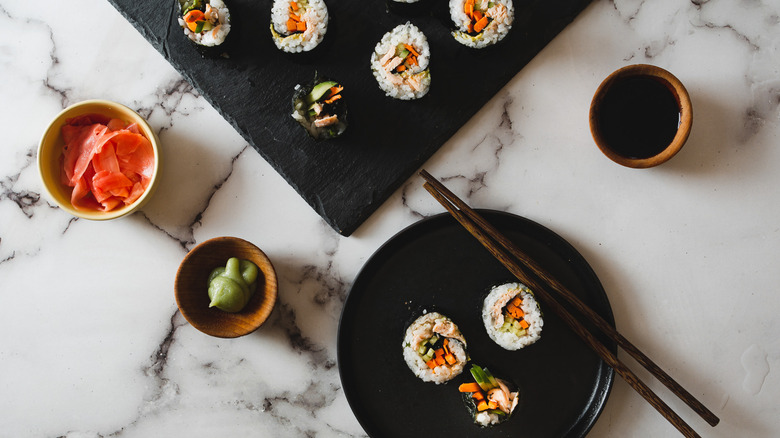
- 3 cups cooked short-grain white rice, warm
- 3 tablespoons seasoned rice vinegar
- 2 tablespoons sugar
- 6 ounces salmon, skin removed
- 1 teaspoon salt
- 1/2 teaspoon pepper
- 1 medium carrot, peeled and julienned (1 cup)
- 2 Lebanese cucumbers or 1 English cucumber, julienned (1 cup)
- 1/2 large avocado, thinly sliced
- 4 sheets toasted nori
- 1 tablespoon toasted sesame seeds
- Soy sauce, for serving
- Pickled ginger, for serving
- Wasabi, for serving
- Spicy mayonnaise (mayonnaise and Sriracha, mixed together), for serving
- Season the rice with rice vinegar, sugar, and salt, and stir to combine. Cool to room temperature.
- Preheat the oven to 400 degrees Fahrenheit. Line a baking sheet with parchment paper or aluminum foil.
- Season the salmon with 1/2 teaspoon of salt and 1/4 teaspoon of pepper on each side. Transfer the fish to the baking sheet and roast until just cooked through, 8 to 10 minutes. Cool, then flake with a fork into large bite-sized pieces.
- Arrange julienned carrots, cucumbers, and avocado slices in separate bowls.
- On a cutting board or flat surface, lay a bamboo sushi rolling mat. Place a piece of nori on the mat, shiny side down.
- Set a small bowl of warm water beside your sushi mat. Wet your hands, and spread approximately 3/4 cup of rice across 2/3 of the nori sheet, leaving about 1/3 of the nori sheet empty on the top.
- Starting about 1 inch from the bottom of the rice, arrange a layer of carrots, followed by a layer of cucumbers, then a spoonful of salmon, and a few slices of avocado. Sprinkle with sesame seeds.
- Grab the mat and lightly hold the nori from the bottom. Begin to roll the mat upwards, firmly applying pressure down to keep the roll tight, using your fingers to tuck any errant filling in. Continue rolling tightly until you reach about 1 inch from the top. Wet your fingers, and dab a small amount of water along the edge of the nori, to act as a sealant. Dab a couple of grains of rice in the middle of the moist row (it also helps bind the nori together). Finish rolling the baked salmon roll completely.
- Transfer the baked salmon roll to a cutting board. With a very sharp chef's knife that's been dipped quickly in water tinged with vinegar, cut the roll in half, and then cut each half into three equal portions. You can also cut off the sides for a neater appearance.
- Repeat with remaining rolls until you run out of ingredients.
- Serve baked salmon sushi rolls with soy sauce, wasabi, and pickled ginger. Accompany with spicy mayonnaise if desired.
Nutrition
| Calories per Serving | 726 |
| Total Fat | 12.4 g |
| Saturated Fat | 2.4 g |
| Trans Fat | 0.0 g |
| Cholesterol | 23.4 mg |
| Total Carbohydrates | 130.2 g |
| Dietary Fiber | 3.5 g |
| Total Sugars | 8.3 g |
| Sodium | 711.2 mg |
| Protein | 20.4 g |
